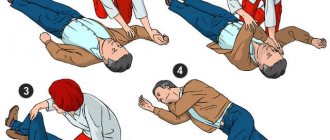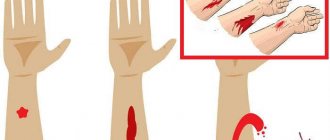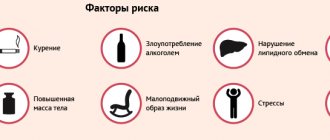Shock is a pathological reaction of the body that occurs in response to irritation caused by a traumatic factor (or a combination of factors) of excessive force, which the body is not able to cope with. Shock is a violation of the vital functions of the body and is a direct threat to human life.
Degrees
A state of shock is the body’s reaction to traumatic external stimuli, designed, in essence, to support the life of the victim. However, depending on the history of the origin of the shock state, as well as on the individual characteristics of the body, it can have the exact opposite, destructive effect.
Degrees
There are 4 degrees of shock.
- It is characterized by a slow reaction of the victim and an increase in heart rate to 100 beats per minute.
- The pulse already rises to 140 beats per minute, and the systolic pressure drops to 90-80 mm. The reaction is just as inhibited as in the first degree, but in this situation the implementation of appropriate anti-shock actions is already required.
- The person does not react to the environment, speaks only in a whisper, and his speech is usually incoherent. The skin is pale, the pulse is almost not palpable, only in the carotid and femoral arteries. The frequency of beats per minute can reach 180. This condition is characterized by increased sweating and rapid breathing. The pressure drops to 70 mm.
- This is a terminal condition of the body, the negative consequences of which are irreversible. In this case, the heartbeat is almost impossible to hear, the state is more unconscious, and breathing is accompanied by convulsive contractions. The person does not react to external stimuli, and the skin has a cadaverous hue, and the blood vessels are clearly visible.
Signs of development of traumatic shock
Traumatic shock is characterized by 2 stages:
- erectile (excitement);
- torpid (lethargy).
In a person who has a low level of adaptation of the body to tissue damage, the first stage may be absent, especially with severe injuries.
Each stage has its own symptoms.
Symptoms of the first stage
The first stage, which occurs immediately after injury, is characterized by severe pain, accompanied by screams and moans of the victim, increased excitability, and loss of temporal and spatial perception.
Observed
- pale skin,
- rapid breathing,
- tachycardia (accelerated contraction of the heart muscle),
- elevated temperature,
- dilated and shiny pupils.
Pulse rate and blood pressure do not exceed normal. This condition can last several minutes or hours. The longer this stage, the easier the subsequent torpid stage passes.
Symptoms of the second stage
The stage of inhibition during traumatic shock develops against the background of increasing blood loss, leading to deterioration of blood circulation.
The victim becomes
- lethargic, indifferent to the environment,
- may lose consciousness
- body temperature drops to 350C,
- pallor of the skin increases,
- lips take on a bluish tint,
- breathing becomes shallow and rapid.
- blood pressure drops and heart rate increases.
Causes of shock
Depending on the cause of the shock, there are several types.
- Hypovolemic shock. Hypovolemic shock is usually caused by a sudden loss of large amounts of fluid from the body.
- Traumatic. Traumatic is usually the consequence of a recent injury, for example, an accident, electric shock, etc.
- Anaphylactic. Anaphylactic is caused by the ingestion of substances into the body that provoke an acute allergic reaction.
- Painful endogenous. Endogenous pain occurs with acute pain associated with diseases of the internal organs.
- Post-transfusion. Post-transfusion may be a reaction to the injection
- Infectious-toxic. Infectious-toxic - shock provoked by severe poisoning of the body.
We recommend reading:
Sights of Venice
In any case, this is not an exhaustive list of the causes of shock. After all, a lot depends on the person himself and the circumstances in which he finds himself.
Symptoms
Toxic shock syndrome - diagnosis
Because TSS is rare, most doctors will never see a case of it. It is important that doctors are able to recognize the disease as the condition progresses quickly. The doctor will look for the most common symptoms and determine the cause of the organ failure. Blood and urine tests help determine organ function or failure.
Your doctor may look for the following signs:
- Temperature above 39 to 40.5 degrees Celsius
- Low blood pressure
- Skin rash
- Evidence that at least three organs are affected by infection
Samples will be taken from any lesions such as the nose, throat, vagina or blood. Imaging tests such as ultrasound, CT or MRI can reveal tissue damage.
Toxic shock syndrome - treatment
Doctors' goal is to fight the infection and also support body functions that may have been affected by the infection. The patient will be hospitalized and placed in the intensive care unit.
Treatment may include:
- Oxygen
: The patient is usually given oxygen to support breathing - Fluids
: will help prevent dehydration and return blood pressure to normal - A dialysis machine
will help treat kidney failure by filtering toxins and waste from the bloodstream - Damage to the skin, fingers or toes
: Treatment may include drainage and cleaning of wounds in these areas, and in severe cases, amputation - Antibiotics
: These can be given intravenously, directly into the bloodstream - Immunoglobulin
: Donated blood samples with high levels of antibodies can be given to combat the toxin, sometimes along with antibiotics
Patients may have to spend several weeks in the hospital.
Symptoms of shock
The symptoms of shock depend not only on the degree, but also on its cause. Each variety manifests itself differently, some with less, some with greater consequences. But initially, the onset of shock is characterized by an increase in the number of pulse beats per minute, a decrease in systolic pressure, and pale skin.
In cases of anaphylactic shock, bronchospasm may occur, which, if first aid is not provided in a timely manner, can lead to death. In case of hypovolemic shock, a striking symptom will be constant and severe thirst, as there is a violation of the water-salt balance in the body.
Moreover, we are talking here not only about blood loss: fluid can be actively removed from the body through vomit and liquid feces. That is, any poisoning with its characteristic symptoms can cause hypovolemic shock. If we are talking about painful endogenous shock, then it all depends on which organ is suffering. The primary state of shock may be accompanied by pain in it.
First aid
Diagnosis of anaphylaxis
Currently, medical research is not able to predict in advance the possibility of an anaphylactic reaction if it has never occurred before. The risk group includes anyone suffering from allergies. The diagnosis itself is made later: either during the reaction itself based on the symptoms and the speed of their development, or after relief. Due to the enormous danger of delay, which can lead to death, it is not possible to study in detail each of the characteristic signs of anaphylaxis. The speed with which health deteriorates requires prompt treatment.
Detection of the allergen that provoked such a reaction in the body is an important step following the treatment of anaphylaxis. If you have not encountered allergies before, then all the necessary specific studies should be carried out for you, which clarify the diagnosis of allergies in general and the cause of an anaphylactic reaction in particular:
- Skin tests
- Skin or patch tests (Patch test)
- Blood collection for IgE testing
- Provocative tests
The purpose of laboratory tests is to accurately identify the allergen that leads to a given reaction. To ensure safety in case of an excessively strong response from the body, the study should be carried out as carefully as possible.
RAST (radioallergen sorbent test) is considered the safest test. This radioimmunological method allows you to most accurately determine the culprit of anaphylaxis without interfering with the activity of the patient’s body. To carry it out, the interaction of the victim’s blood with allergens successively added to it is analyzed. The release of a significant amount of antibodies after the next injection indicates the detection of the allergen that caused the reaction.
First aid for shock
First of all, it is necessary to visually examine the victim and try to determine what caused the shock. If necessary, ask him a few clarifying questions. Next, if you do not find any external injuries, carefully place the patient in a horizontal position.
If there is vomiting or bleeding from the mouth, turn his head to the side to prevent him from choking. If the victim has a back injury, under no circumstances should he be moved or laid down. You need to leave it in the position in which it is currently located. Provide first aid if open wounds are detected: bandage, treat, apply a splint if necessary.
Before the ambulance arrives, monitor vital signs such as pulse, heart rate, and breathing.
Who is most susceptible to this?
In addition to people who once experienced deep psychological trauma that left an indelible mark for the rest of their lives, people who are currently deeply depressed are considered the most emotionally vulnerable. Stress itself can give rise to shock situations, seemingly out of nowhere. Those who recently experienced a series of events that led to losses and losses are too vulnerable. People seem to cease to belong to themselves; any unexpected cry or surprise can already cause the notorious state of shock.
Features of the treatment of shock conditions
Before prescribing treatment for a shock condition, it is necessary to find out the cause of its origin and. if possible. eliminate it. In case of hypovolemic shock, it is necessary to compensate for the volume of lost fluid with the help of blood transfusions, IVs, etc. This happens, for example, with mountain sickness. To saturate the body with oxygen, oxygen therapy is used in the form of inhalations.
We recommend reading:
How to light a fire without matches
In case of anaphylactic shock, antihistamines are introduced into the body, and if it comes to bronchospasm, the method of artificial ventilation is used. Traumatic shock is eliminated by the administration of painkillers. Relief may not come immediately. It all depends on the severity of the injury.
The state of shock caused by poisoning is corrected by removing toxic toxins from the body. Moreover, in this case it is necessary to act quickly: if the poisoning is severe, the consequences may be irreversible. In case of painful endogenous shock, timely assistance will help get rid of it, and in the future – complex therapy aimed at treating the disease. causing shock.
Shock
How long does shock last?
There is no average number of hours indicating how long shock may last. A very average indicator suggests that the state of shock can last up to two days. But, as with treatment, it all depends on the type and severity of the injury or other ailment. This also determines how long a person can live without food.
In rare cases, not only anaphylactic shock can lead to death: if the state of shock is caused by an external injury, then with severe painful shock a person can be killed by a heart attack.
Therefore, the sooner a person is brought out of a state of shock, the less negative the consequences will be for both the physical state of the body and the psychological one.
In any case, timely medical care can prevent irreversible changes that can be caused by a state of shock. If a person finds himself face to face with an extreme situation, only his own self-control and willpower can bring him out of a state of shock.
However, diagnosing shock for yourself is not so easy, so the first thing you need to do is try to calm down and not panic, and then look at the circumstances.
Author of the publication
offline 2 years
Nika
7
I am interested in hiking and traveling, photography and videography. I have been going hiking since childhood. The whole family went and went - sometimes to the sea, then to the river, to the lake, to the forest. There was a time when we spent a whole month in the forest. We lived in tents and cooked over fires. This is probably why I am still drawn to the forest and, in general, to nature. I travel regularly. About three trips a year for 10-15 days and many 2 and 3 day hikes.
Comments: 0Publications: 668Registration: 10/23/2018
Nika Survival in the wild, Medical assistance, Articles
What is shock and how to cope with it - advice from a psychologist
A state of shock is a mental response to an unexpected or excessive stimulus. A person cannot adapt to the situation and “falls out” into an altered state of consciousness. This reaction cannot be controlled; it occurs on an unconscious level.
From a strong shock, a person can freeze in place when he needs to run. Or, conversely, do something that you were unable to do before. A strong shock can cause our entire body to react and disable it.
“You cannot do without the help of specialists in such situations. This state is essentially a trance. The psyche is subjected to a real hypnotic effect. In the future, a person may give unexpected reactions to certain circumstances. Perceiving harmless situations as dangerous. At the same time, “with his head” he perfectly understands that there is no reason for such a reaction, but emotionally he experiences severe anxiety,” explains the psychologist.
With milder shocks, the effect of the shock may not be as noticeable. The person gradually comes to his senses and moves on with his life. However, what happened in his psyche may come back to haunt him in the most unexpected way.
The slight shock caused by a sudden event induces a slight trance. A person may not even notice it. But even in these few minutes, the psyche is subject to hypnotic influence.
“That is, shocking information on TV and the subsequent advertising of something may well act as suggestion. You won’t even be able to trace the connection, but you will give a certain reaction,” the psychologist noted.
Three tips on how to survive shock:
1. Improve your breathing
You need to establish even breathing. Breathe and say: “I inhale, I exhale.” It is also necessary to “ground yourself” - for this it is best to sit on a chair so that you can feel support with your legs (you do not need to cross them). If this is not possible, then you can lean on a wall or another person. Usually, it takes no more than 10 minutes in this position to cope with the shock.
2. Be there
To help a person in shock, you need to be close to him. But don’t suggest anything from the “everything will be fine” series, don’t ask about what happened (this will lead to repeated shock) and don’t drag him anywhere. You can hug by placing your hands between your shoulder blades. When the person comes to his senses a little, give him tea with sugar.
3. Personal recipe
There are psychotechnics invented by people themselves. For example, a soldier, if he was in shock, was advised to bite his own lip until it bled. Then look at the blood. The numbness immediately subsides. The secret is not in the form of blood, but in a strong-willed effort, in the desire to take control and responsibility for one’s life. When you hurt yourself, you suppress your animal instincts, which are always aimed at self-preservation. By biting your lip, you act unnaturally - you harm your body, but you are born a rational person, suppressing the animal nature in yourself.
Department of Labor and Social Protection of the Moscow Population for the “New Pensioner”











